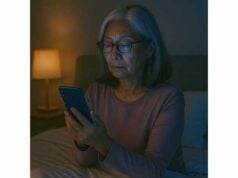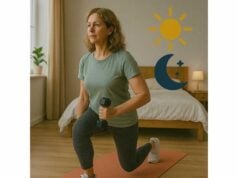
Loneliness is not just a feeling—it is a whole-body stressor that reshapes sleep, mood, and recovery. As social rhythms fray in midlife and later life, many people notice lighter, more fragmented nights and slower mornings. The good news is that small, intentional acts of connection can stabilize sleep biology: they lower threat vigilance, improve bedtime wind down, and make wake times feel steadier. This guide explains how loneliness disrupts nighttime physiology and shows how to build practical, repeatable social habits that protect sleep and healthspan. For a broader view of how rest interacts with stress and recovery across the lifespan, see our foundation on sleep, stress, and recovery strategies. Then come back here to choose two changes for the next week—one daytime behavior, one evening ritual. The aim is not more contacts; it is better, more nourishing contact that supports the nights you want.
Table of Contents
- How Loneliness Disrupts Sleep and Stress Physiology
- Daytime Social Habits That Support Better Nights
- Evening Wind Down with Connection and Gratitude
- Digital Versus In Person: Finding the Right Balance
- Caregivers and Widowed Adults: Special Considerations
- Community, Volunteering, and Group Activities for Sleep
- Measuring Impact: Sleep Quality, Mood, and Energy
How Loneliness Disrupts Sleep and Stress Physiology
Loneliness changes how the brain monitors the world at night. When social safety feels uncertain, the nervous system tilts toward vigilance. That shift shows up as more time in lighter stages of sleep, more awakenings, and more next-day fatigue—even if total time in bed looks adequate. Three mechanisms drive this pattern.
1) Heightened arousal at night. The brain’s threat-detection systems run a little hotter when people feel isolated. That means noise, light, or a minor discomfort is more likely to trigger a full awakening. Even short arousals compound across the night, lowering sleep efficiency (minutes asleep divided by minutes in bed) and creating the sense of “I’m in bed for eight hours but it never feels like eight.”
2) Altered circadian signals. Human clocks synchronize through light, activity, and social cues. Regular conversations, shared meals, and predictable daily check-ins act like time givers (zeitgebers). When the day loses these anchors, bedtimes drift and wake times stretch, which degrades the quality of the final sleep cycles. Many lonely adults find themselves sleeping later yet feeling less restored, because irregularity trims REM-rich late-night sleep.
3) Inflammation and autonomic imbalance. Chronic loneliness is linked with higher sympathetic tone (the body’s “go” system) and pro-inflammatory signaling. These changes interfere with deep sleep consolidation and amplify pain sensitivity. The net effect is a loop: poor sleep raises pain and stress reactivity; higher reactivity makes sleep lighter; lighter sleep leaves mood less resilient to social stress.
It helps to think of loneliness as a sleep context more than a diagnosis. Improving sleep does not require a crowded calendar. It requires enough secure connection to dial down vigilance, along with predictable day–evening rhythms. Two patterns are especially powerful:
- Predictable daytime contact. A short, meaningful check-in at roughly the same time each day provides a strong social time cue.
- Consistent, low-stress evenings. Gentle connection (quiet talk, shared routines) lowers cognitive load before bed and preserves the final third of the night, where REM sleep concentrates.
The rest of this guide turns those principles into specific, repeatable steps you can test and track over the next month.
Daytime Social Habits That Support Better Nights
Your daytime social rhythm sets the stage for your night. Two levers—regularity and quality—matter more than total hours spent with people. The aim is to build a stable scaffolding of contact that anchors your clock and eases the task of unwinding at dusk.
Build a two-anchor day.
Choose two recurring touchpoints that happen nearly every day, even when you are busy:
- Morning activation (10–30 minutes): a neighbor walk, a call while making breakfast, or a group class. Pair it with bright morning light to reinforce timing. If you are rebuilding structure after a move or retirement, start with a single contact at a fixed time for two weeks to establish traction. For circadian support ideas that complement social anchors, see simple light habits.
- Late-afternoon check-in (5–15 minutes): a quick message or voice memo with a friend, caregiving team, or family member. Keep it brief and consistent. This contact prevents the long social “fast” that often precedes lonely evenings.
Prefer “shared doing” over “small talk.”
Activities with light coordination—walking, a cooking group, a community garden—are easier to sustain than open-ended chats. They combine movement, light exposure, and purpose, which lowers allostatic load (wear-and-tear from chronic stress). If mobility is limited, “co-presence” sessions (e.g., 20 minutes of reading together on video) create connection with minimal logistics.
Use micro-connections strategically.
- Habit stacking: attach a 2–3 minute message to an existing routine (after lunch, before starting the car).
- Prompted gratitude: once a day, send a brief note that names one concrete thing you appreciated about someone that week. The specificity keeps it genuine and supports later wind down.
- Social meal planning: schedule one shared meal each week, even if it is virtual. Shared mealtimes nudge sleep-friendly timing by anchoring dinner earlier.
Balance your energy budget.
Introversion or chronic illness may limit capacity for live events. Favor predictable, low-stakes contact that does not require travel or complex planning. It is better to hold two weekly interactions for six months than to attend a burst of events and relapse into isolation.
If anxiety blocks outreach, lower the hurdle.
Draft message templates (e.g., “Thinking of you. Would you like a 10-minute call this week?”). Rotate through three names. When momentum returns, your replies will create their own rhythm.
A two-week starter plan
- Week 1: Add one fixed morning contact. Keep a simple log: yes/no, and mood at noon (0–10).
- Week 2: Add a late-afternoon check-in and plan one shared meal (in person or video). Note bedtime and wake time consistency. Aim for ±30 minutes.
You should not need more than two or three anchors to notice steadier evenings and fewer late-night ruminations. If you are already well-connected but sleep remains erratic, consider whether timing (late dinners, late exercise) is the real bottleneck and adjust accordingly.
Evening Wind Down with Connection and Gratitude
Evenings are where loneliness and sleep most often collide. The aim is to lower arousal without numbing out. Think “warm shutdown,” not “off switch.” Two types of connection help: gentle co-presence and reflective practices that reduce threat signaling.
Design a 60–90 minute downshift.
- T-90: Dim lights and reduce cognitive load. Save complex decisions for tomorrow’s list.
- T-60: Choose one low-stakes connection: a quiet call, partner talk, or shared TV with rules (no news, no late-night cliffhangers).
- T-20: Transition to a solo reflective practice—journal, short prayer, or guided breathwork. If breath pacing helps you relax, try a 4-6 pattern (inhale 4 seconds, exhale 6) for 5–10 minutes. For structured options, explore basic breathing sequences that support autonomic balance.
Use gratitude with specificity, not as a slogan.
Gratitude works best when you name details (the neighbor who moved your bin; a kind text from your daughter; the sun on your walk). Aim for three specific items, written or spoken. If writing, end with one action you will take to reciprocate or pay it forward this week. This keeps gratitude from becoming performative and links it to prosocial behavior, which deepens the social safety signal your brain receives at bedtime.
Replace lonely scrolling with “closing loops.”
Late-night social media can feel like connection but often creates comparison and cognitive churn. Instead, “close loops”: send one thank-you, one “thinking of you,” and one RSVP or plan. Once sent, put devices in a fixed charging spot outside the bedroom. If screens remain in the evening, apply screen hygiene—low brightness, warmer hues—and set a media cutoff that protects the final 30–60 minutes before lights-out.
For couples: try an “off-ramp question.”
Each night, trade one question that cannot be answered with “fine.” Examples: “What surprised you today?” or “What did you change your mind about this week?” Keep it short and curiosity-led; the goal is soft connection, not problem-solving.
If you live alone: schedule “companioned wind down.”
Ask a friend to co-wind-down twice a week on video for 10–15 minutes. Keep it ritualized—tea, quick check-in, two specific gratitudes each—and then log off. You are aiming for predictable, low-stimulus contact that leaves you calmer than when you started.
If grief or worry spikes at night: keep a bedside capture tool.
Set a notepad by the bed. When ruminations start, write a single line (“Call pharmacy about refill,” “Email grandson about Saturday”). Close the notebook. Your brain sees that the task has a container; arousal often drops enough to re-enter sleep.
The great mistake is trying to force sleep through ever-longer routines. Keep your wind down compact, connective, and repeatable—30 to 60 minutes is plenty when the pieces fit.
Digital Versus In Person: Finding the Right Balance
Digital tools are neither heroes nor villains for sleep. Their impact depends on what you use, when you use it, and how it makes you feel afterward. The right mix preserves social nourishment while protecting evening physiology.
In-person connection: deeper signal, higher friction.
Face-to-face time offers richer nonverbal cues and oxytocin-linked bonding that often quiets stress systems more reliably than text-based contact. It also takes planning, travel, and energy. For many older adults, a weekly in-person anchor (club, faith group, class, family dinner) plus lightweight digital ties is the sustainable sweet spot.
Digital connection: flexible, scalable, easy to overdo.
Messaging, group chats, and video calls can keep distant relationships alive and fill daytime gaps. But social apps are engineered for engagement, not restoration. Scrolling past bedtime displaces the final REM-rich cycles and can elevate arousal—especially with news or contentious threads.
How to get the benefits without the sleep costs
- Time-box evening digital use. Set a device shutdown 60 minutes before lights-out. If you need a late check-in (time zones, caregiving coordination), cap it at 10 minutes and switch to audio-only to reduce visual stimulation.
- Prefer synchronous over endless asynchronous. Real-time calls or short voice notes provide clearer closure than sprawling text threads. Closure is your friend at night; it tells the brain that social business is complete.
- Curate your digital neighborhood. Mute or leave groups that predictably raise your heart rate. Add friction: uninstall late-night triggers from the phone and keep them on a tablet that stays outside the bedroom.
- Use tech to schedule real life. Treat platforms as coordination tools, not destinations. End a message with a plan (“Walk Wed 9:30?”), then log off.
Video calls that calm rather than rev up
- Keep them short (10–20 minutes) and agenda-light.
- Use softer lighting and steady framing; visual jitter increases effort.
- Close with a next-step (“Talk Sunday?”), which lowers post-call rumination.
For screen-sensitive sleepers: combine social with light hygiene.
Evening screens delay dim-light melatonin onset if bright and close to the eyes. Pair your digital cutoff with room lighting that moves low and warm. If you must use a screen later, drop brightness, increase text size, and keep the device farther from the eyes. For a practical primer on screen hygiene that supports sleep, see evening light strategies.
The rule of thumb: Use digital to enable connection and closure; use real life to deepen it. When in doubt, choose the format that leaves you calmer 30 minutes later.
Caregivers and Widowed Adults: Special Considerations
Caregiving and bereavement reshape both days and nights. The stress is practical (tasks, finances) and relational (role changes, loss of a partner’s co-regulation). Sleep often becomes lighter and more fragmented, and daytime fatigue accumulates. Tailored strategies help.
For caregivers: build micro-rest and micro-help into the week.
- Relief windows: Put two non-negotiable 30–60 minute relief blocks on the calendar each week, ideally at the same times. Use them for a nap, a quiet walk, or a call with a supportive friend—not chores.
- Task bundling: Consolidate low-stakes updates to one daily message thread with the care team; reduce late-night texting that keeps you mentally “on call.”
- Noise management: If nighttime monitoring is essential, consider devices that alert only for meaningful events and keep the bedroom otherwise quiet and dark.
- Compassionate boundaries: A short bedtime ritual that signals “off duty for now” (journal, brief prayer, or breath practice) helps lower arousal enough to re-enter sleep after nighttime care tasks.
For widowed adults: restore evening co-regulation.
Losing a partner removes a major sleep buffer—shared wind down and co-presence. To rebuild that signal:
- Create “companioned evenings” twice weekly. Tea with a neighbor, a small group dinner, or a faith meeting. Keep logistics simple.
- Anchor self-soothing. A consistent 10-minute practice—gratitude entries naming three specifics, or a gentle body-scan—reduces nighttime jags of grief-driven arousal.
- Protect mornings. Set a standing morning plan (walk group, call) so you have an external nudge to get light and movement early, even on harder days.
When to seek extra help
- Persistent insomnia (≥3 nights/week for ≥3 months) despite good sleep hygiene.
- Safety concerns (drowsy driving, near-falls from fatigue).
- Depressed mood most of the day for two weeks, or loss of interest in previously enjoyed activities.
- Frequent nighttime panic or dream enactment; these require evaluation to rule out treatable conditions.
Community resources that reduce friction
Look for caregiver coalitions, bereavement groups, and local senior centers that offer transportation or phone-based meetups. The goal is predictable, low-friction support. Even one weekly group can provide enough emotional ballast to steady the night.
If rumination or hyperarousal keeps you awake, a structured approach like CBT-I can help you rebuild sleep efficiency without medications. A concise, stepwise guide is available at practical CBT-I steps.
Community, Volunteering, and Group Activities for Sleep
Belonging improves the inputs that produce better sleep: regular schedules, daylight exposure, movement, and a sense of purpose. Community activities bundle these inputs, which is why they often deliver outsized gains for sleep and mood.
Choose activities with “sleep-positive” features
- Daylight exposure: Outdoor groups (walking clubs, gardening, clean-ups) provide bright morning or midday light that anchors circadian timing.
- Predictability: Weekly classes and standing meetings create natural bookends for sleep routines.
- Light-to-moderate exertion: Gentle exercise reduces muscle tension and evening arousal without causing late-night overheating.
- Prosocial goals: Helping others reduces self-focused rumination, a common driver of nocturnal wakefulness.
Volunteering that fits different energy levels
- Low energy, high meaning: library shelving, phone reassurance programs, meal packing.
- Moderate energy: park cleanups, school reading buddies, animal shelter socialization.
- Higher energy: community sports officiating, trail workdays, charity event setup.
Build a month you can repeat
- Pick one weekly anchor (e.g., Wednesday morning walking group).
- Add one “give” (two hours of volunteering every other week).
- Add one “learn” (class, faith study, or workshop).
Together, these create three predictable social time cues that reinforce a regular sleep–wake schedule.
Travel or mobility limitations?
Use hybrid participation: dial-in book clubs, phone pen-pal programs, or video-based classes. Many organizations now offer home-based roles. The key is consistency, not proximity.
Avoid the overcommitment trap
Too many obligations compress evenings and push dinner late, a direct hit to the final third of the night where REM sleep concentrates. Ruthlessly protect a one-hour wind-down on event days. If a group often runs late, choose an earlier cohort or switch to a daytime slot.
Track the right outcomes
Notice whether community days make the next morning feel steadier—faster get-up, better focus, more positive mood. If yes, keep them. If you return wired and underslept, adjust timing (earlier events, shorter sessions) before abandoning the activity.
To make bedroom conditions match your new routines—cooler, darker, and quieter—scan these simple environment upgrades at bedroom, temperature, and noise tips.
Measuring Impact: Sleep Quality, Mood, and Energy
You do not need a laboratory to see whether connection is improving your nights. A light-touch scorecard, kept for four weeks, will show you what actually helps.
Pick three metrics you can sustain
- Sleep quality (0–10): On waking, rate depth and restfulness, not perfection.
- Mood energy (0–10): Mid-morning, rate steady energy and willingness to engage.
- Sleep efficiency proxy: Time in bed versus estimated time asleep (from a wearable or your best estimate). The goal is a rising trend, not a target number.
Optionally add snoring minutes, resting heart rate, or bedtime consistency (± minutes) if you already track them. The more numbers you add, the greater the risk of noise and overwhelm. Start simple.
Run one change per week
- Week 1: Add a fixed morning contact and a short late-afternoon check-in.
- Week 2: Insert a 30–60 minute, low-stimulus evening wind down with a brief gratitude entry.
- Week 3: Replace late-night scrolling with three “closing loops” (thank-you, thinking-of-you, and plan). Charge devices outside the bedroom.
- Week 4: Add one standing group activity or volunteering block.
Judge by trends, not single nights
Expect two steps forward, one back. Illness, travel, or weather will bump the line. What matters is the slope over four weeks: more mornings at 6–8/10, fewer chaotic bedtimes, and quicker sleep onset. If metrics stall, ask whether logistics (late dinners, bright evening light) are blocking gains and adjust.
Use your bed partner wisely
If you share a room, ask for one weekly rating of your sleep steadiness (0–10) and evening mood. Bed partner observations often catch wins you miss—quieter turning, fewer sighs, more even breathing.
When to escalate
If you still wake unrefreshed after a month of better routines and connection, or if you snore loudly with witnessed breathing pauses, request a sleep evaluation. Some problems—sleep apnea, restless legs—need targeted treatment. Bringing your four-week scorecard to the visit helps your clinician see patterns fast.
Keep the loop tight
- Set Sunday reviews: 10 minutes to note what worked and choose next week’s tiny tweak.
- Celebrate process wins (doing the ritual), not just outcome wins (perfect nights).
- Share your plan with one person; light accountability strengthens follow-through.
Connection supports sleep because it reduces the brain’s need to keep watch. With a stable daytime rhythm and a quiet evening close, nights have permission to do their work.
References
- Loneliness and sleep: A systematic review and meta-analysis 2020 (Systematic Review and Meta-analysis)
- Social isolation as a risk factor for all-cause mortality 2023 (Systematic Review and Meta-analysis)
- The effects of gratitude interventions: a systematic review and meta-analysis 2023 (Systematic Review and Meta-analysis)
- Sleep quality and in-person versus online social interaction as predictors of change in affect and interpersonal needs 2023 (Observational Study)
- The relationship between burden and caregiver’s sleep quality: a systematic review 2023 (Systematic Review)
Disclaimer
This article offers general, educational information about social connection, loneliness, and sleep. It is not a substitute for personal medical advice, diagnosis, or treatment. If you have persistent insomnia, symptoms of depression, loud snoring with breathing pauses, or safety concerns such as drowsy driving, seek professional evaluation. Discuss any new routines, supplements, or therapies with your clinician, especially if you manage cardiovascular, respiratory, or mental health conditions.
If you found this guide useful, please consider sharing it on Facebook, X, or your preferred platform, and follow us on social media. Your support helps us continue to produce careful, evidence-based resources for our community.










